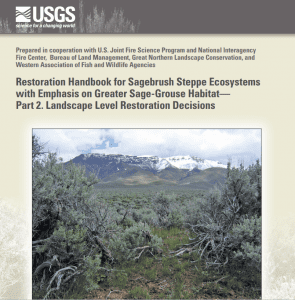Sage-Grouse Conservation - A Collection of Resources
View article.
This study developed range-wide population and habitat models for greater sage-grouse (Centrocercus urophasianus) that account for regional variation in habitat selection and relative densities of birds for use in conservation planning and risk assessments. The models demonstrate distinct clustering of relative abundance of sage-grouse populations across all management zones. On average approximately half of the breeding population is predicted to be within 10% of the occupied range. We also found 80% of sage-grouse populations were contained in 25 – 34% of the occupied range within each management zone. Range-wide population and habitat models account for regional variation in habitat selection and the relative densities of birds, thus they can serve as a consistent and common currency to assess how sage-grouse habitat and populations overlap with conservation actions or threats over the entire sage-grouse range.
View handbook.
This handbook walks managers and practitioners through a number of site-specific decisions managers face before selecting the appropriate type of restoration. This site-level decision tool for restoration of sagebrush steppe ecosystems is organized in nine steps.
- Step 1 describes the process of defining site-level restoration objectives.
- Step 2 describes the ecological site characteristics of the restoration site. This covers soil chemistry and texture, soil moisture and temperature regimes, and the vegetation communities the site is capable of supporting.
- Step 3 compares the current vegetation to the plant communities associated with the site State and Transition models.
- Step 4 takes the manager through the process of current land uses and past disturbances that may influence restoration success.
- Step 5 is a brief discussion of how weather before and after treatments may impact restoration success.
- Step 6 addresses restoration treatment types and their potential positive and negative impacts on the ecosystem and on habitats, especially for greater sage-grouse. We discuss when passive restoration options may be sufficient and when active restoration may be necessary to achieve restoration objectives.
- Step 7 addresses decisions regarding post-restoration livestock grazing management.
- Step 8 addresses monitoring of the restoration; we discuss important aspects associated with implementation monitoring as well as effectiveness monitoring.
- Step 9 takes the information learned from monitoring to determine how restoration actions in the future might be adapted to improve restoration success.
View handbook.
This handbook is intended to assist decision makers in determining landscape objectives, to identify and prioritize landscape areas where sites for priority restoration projects might be located, and to aid in ultimately selecting restoration sites guided by criteria used to define the landscape objectives. The landscape restoration decision tool is structured in five sections that should be addressed sequentially. Each section has a primary question or statement followed by related questions and statements to assist the user in addressing the primary question or statement.
View handbook.
This handbook discusses concepts surrounding landscape and restoration ecology of sagebrush ecosystems and greater sage-grouse that habitat managers and restoration practitioners need to know to make informed decisions regarding where and how to restore specific areas, by providing:
- Descriptions of plant dynamics of sagebrush steppe ecosystems and their responses to major disturbances, fire, and defoliation.
- Introductions of the concepts of ecosystem resilience to disturbances and resistance to invasions of annual grasses within sagebrush steppe.
- Introductions to soils and ecological site information will provide insights into the specific plants that can be restored in a location.
- Descriptions of concepts of landscape ecology that aid decisions regarding habitat restoration.
- Overviews of restoration techniques for sage-grouse habitat restoration.
- Descriptions of the critical nature of monitoring for adaptive management of sagebrush steppe restoration at landscape- and project-specific levels.





